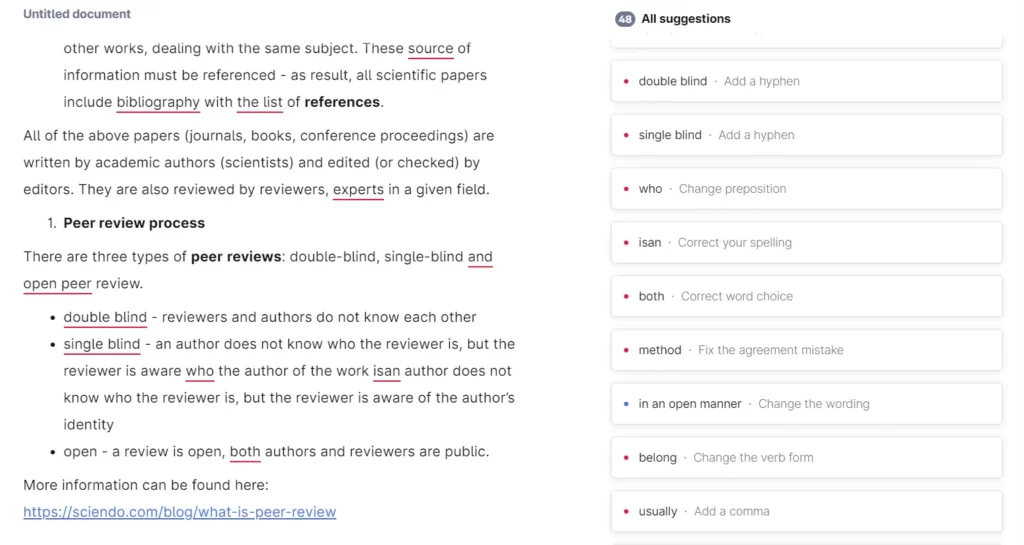How to polish your writing style with a language editing service?

Are you looking for ways to publish your latest research results or the book you have been working on? The chances are you may be feeling overwhelmed by all the steps in the publication process. The process is complex and might be difficult, especially if you are just embarking on your journey as an author.
We have prepared a series of helpful articles to guide you through the manuscript production process. In this piece, we cover the language editing that opens up the process. To read about the other steps just click on the list below:
- language editing
- copyediting
- typesetting (known also as technical editing)
- proofreading
- XML publication (academic publishing only).
What exactly is language editing?
Language editing is the reading of a finished manuscript in search of any errors in spelling, grammar, and punctuation. Its main goal is to improve the clarity and quality of a document before the final publication.
Poor wording is a common reason for the rejection of papers at the submission stage. It is vital to ensure your manuscript reads well to maximise the chances of it being accepted. You may perform the editing task yourself or ask your colleague or mentor to have a second look. Others with a fresh perspective, typically spot errors and mistakes that are not obvious to authors a lot faster.
You can also try using various editing programs or ask the language editor for professional help.
The language editing software
There are many tools available online that can aid authors in the process. They just require uploading or copying of a ready document for automatic scanning. Any errors are usually underlined or highlighted for you to review them, making the editing task easier. The systems offer features such as spell and grammar checking, word choice suggestions, and sometimes also advice on style and structure. Many of these tools contain also an automated format checker which allows users to comply with academic or professional standards.

Language editing software can be a great, time-saving solution for achieving that polished style you are seeking. They will quickly and effortlessly identify existing errors and suggest corrections. Such tools are also a cost-effective language editing alternative, as many of those are available online for free.
Just find the tool that works best for you and ensure your research represents the highest standard before sending it to a journal or publisher.
The language editing service
Online editing tools are typically sufficient when preparing a paper for submission. The final publication may require, however, a second, more in-depth manuscript reading that can be performed only by an expert.
What can you expect from a professional language editing service? The language-checking editor will go through various aspects of the text making sure its writing style is up to the highest standards:
- grammar – every language has a set of rules governing words, sentences, and other components. Poor grammar makes a text difficult to read, so it is vital that no errors occur in the manuscript.
- punctuation – punctuation symbols are used to separate sentences and written elements. When errors appear the whole text may become ambiguous and its interpretation by a reader incorrect.
- syntax – inappropriate arrangement of words in sentences and sentences in phrases disrupts the reading. The language editor will modify the order whenever necessary to increase the clarity and ensure the smooth flow of the text.
- word usage – every manuscript has a specific goal and intended audience. Text designed for commerce is generally written in a different way than a scientific article. The language editor will make sure your research paper contains the best selection of words and suggest alternatives whenever applicable.
- spelling – the expert will check also the text’s compliance with standard orthography and correct any misspelled words that may obscure meaning.

A professional language editor’s role is to provide feedback on the areas in the manuscript where improvements can be made. The service can aid both journal editors as well as individual authors:
- language editing for journals – the service can save paper production time. Editors have full control over the process and authors are not required to go through the processes themselves.
- language editing for authors – the service is invaluable for anyone who wants to submit a high-quality paper or self-publish a book.
Quick tip for journal authors: before making a submission, check what is expected of you in terms of language editing. Some journals provide such a service for all accepted research papers, whereas other expect to receive an already edited manuscript. In case the first is true, you can save time and money on the professional service, and merely use free online tools to ready your paper for submission.
What is English language editing and why is it important?
English is the international language of science. Papers written in English are accessible to scientists around the world, hence most research is published in this language.
Journal editors and scientific publishers expect to receive high-quality manuscripts that can be shared with a global community and widely cited. Papers that are not up to the expected standards are usually immediately rejected.
Poor quality English remains also a common reason for the rejection of scientific publications by prestigious indexing services, such as Clarivate or Scopus. Editors and publishers that look after the best indexing coverage will also make their submission decisions based on that factor.
English language editing is a service that can help to improve manuscripts in terms of grammar, spelling, punctuation, and clarity. It is usually performed by experienced editors with an advanced understanding of the English language.
An English language editing service can significantly improve the quality of the English usage in a paper. It will ensure that your work is as good as it can be, increasing its chances to be published, read and cited.

Language editing services offered by Sciendo
At Sciendo we offer editing services for all of the languages we publish in: English, German, Spanish, Italian, French, and Polish. We work with journal editors and individual book authors.
Each service is available at three different levels, so that you can select the one that exactly matches your needs and manuscript requirements.
If you select one of our Premier packages, we will always provide the most in-depth level of editing.
For English, we offer both British English and American English.
Light Edit
The Light Edit is a style-focused edit that includes:
- minimal corrections to the text beyond style and consistency points
- citation checks
- fundamental grammar corrections
- we do not change the author’s voice unless major grammatical errors occur
- a small number of queries are raised with the author.
Medium Edit
This level includes all tasks of the Light Edit and adds a thorough reading of the text for sense, style, and structure:
- sentences are verified to ensure the tenses match consistently
- definite and indefinite articles are checked for the correct usage
- long, poorly worded and confusing sentences are queried with the authors
- the total number of queries raised is higher than with the Light Edit.
Medium Edit is a suitable balance between quality and cost for most publications.
Heavy Edit
In the Heavy Edit we make corrections to the language even when the meaning is clear:
- we correct the use of fewer/less for countable/uncountable nouns
- predicative/attributive adjectives
- the use of which/that
- revise the structure and language in keeping with the author’s intent and voice
- long or confusing sentences and paragraphs are recast to shorter ones.
- additional attention is given to details in tables and figures to check if they match those in the text itself
- overall, far more author queries are raised during the Heavy Edit.
Overall, this language editing service becomes invaluable if you are looking to improve your manuscript and make it ready for publication. To find out more on how we can help you and to discuss possible options, please complete the form.
Press release: Learning Analytics: a Metacognitive Tool to Engage Students
The presented study is the result of the research project ‘Open Online Learning for Digital and Networked Society (3.3-LMT-K-712-01-0189)’, funded by the European Social Fund according to the activity ‘Improvement of researchers’ qualification by implementing world-class R&D projects’ of Measure No. 09.3.3-LMT-K-712 under the grant agreement with the Research Council of Lithuania (LMTLT).
read moreThe History of Open Access
Open Access publishing first emerged during the late 1980s and early 1990s when academic self-publishing online became possible using email, newsgroups, and the internet.
read moreBenefits of publishing your book in an Open Access model
The number of peer reviewed academic books published in an Open Access model has grown strongly over the past few years. In this article, we summarise what the research says about the major benefits of publishing academic books as Open Access.
read moreThe Article Processing Charge model: what are the benefits it brings to journals co-operating with Sciendo?
Over the last decade Article Processing Charge (APC) has become the main business model for Open Access journals, especially those with commercial publishers.
read moreWhat is typesetting, and why is it important
In this article, we cover another stage of the manuscript production process called typesetting. Typesetting is the process that follows copy editing and turns a paper into its final version, ready for printing and online publication. To read about the other steps in the publishing process click on the links below: What exactly is typesetting? […]
read more